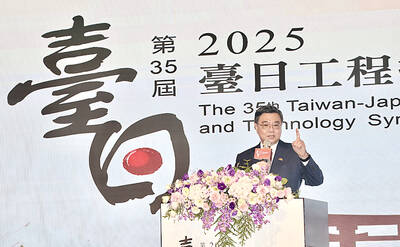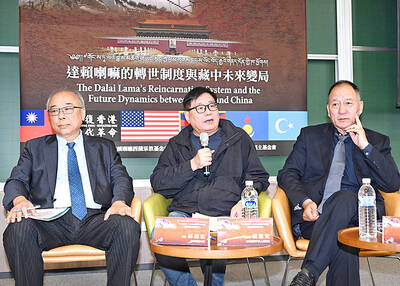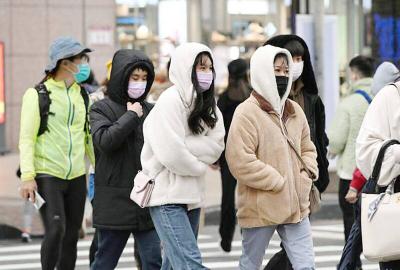Most Taiwanese are upset about the Democratic Progressive Party (DPP) administration’s cross-strait and economic performance, a survey published yesterday showed.
The poll, which focused on public perception of the DPP and Chinese Nationalist Party (KMT), was commissioned by the Taiwan Competitiveness Forum, whose members include former People First Party legislator Pang Chien-kuo (龐建國) and KMT member Hsieh Ming-hui (謝明輝).
More than half of respondents said that the DPP administration does worse than the KMT government when it comes to foreign relations, and 61.7 percent said that cross-strait relations have deteriorated since the DPP assumed power, the survey showed.
As for the economy, 48.8 percent said that it has worsened, while 33.7 percent said that there is little difference between the DPP’s and the KMT’s performance.
Without endorsing the so-called “1992 consensus” and the concept that people from both sides of the Taiwan Strait are “one family,” President Tsai Ing-wen (蔡英文) would not be able to improve the nation’s foreign relations and economic development, Pang said.
The “1992 consensus”— a term former Mainland Affairs Council chairman Su Chi (蘇起) admitted making up in 2000 — refers to a tacit understanding between the KMT and the Chinese Communist Party that both sides acknowledge there is “one China,” with each side having its own interpretation of what “China” means.
Public dissatisfaction with Tsai’s performance reached 64.1 percent, increasing by 3.8 percentage points from a February poll, while dissatisfaction with Premier William Lai’s (賴清德) performance rose 6.4 points to 47.5 percent, Hsieh said.
While Tsai has encouraged government officials to show humility, nearly 40 percent of respondents said that the ruling party has not demonstrated more tolerance for social dissent than the KMT, Hsieh added.
Asked which party they supported, 23.1 percent said the KMT and 14.6 percent chose the DPP, while more than half of respondents had no preference, he said.
The KMT appears to be gaining territory ahead of the Nov. 24 local elections, Hsieh added.
The survey, conducted from July 22 to July 24 by Taiwan Real Survey Co, collected 1,083 valid samples via telephone interviews and had a margin of error of 2.98 percentage points.

ALIGNED THINKING: Taiwan and Japan have a mutual interest in trade, culture and engineering, and can work together for stability, Cho Jung-tai said Taiwan and Japan are two like-minded countries willing to work together to form a “safety barrier” in the Indo-Pacific region, Premier Cho Jung-tai (卓榮泰) yesterday said at the opening ceremony of the 35th Taiwan-Japan Modern Engineering and Technology Symposium in Taipei. Taiwan and Japan are close geographically and closer emotionally, he added. Citing the overflowing of a barrier lake in the Mataian River (馬太鞍溪) in September, Cho said the submersible water level sensors given by Japan during the disaster helped Taiwan monitor the lake’s water levels more accurately. Japan also provided a lot of vaccines early in the outbreak of the COVID-19 pandemic,

Kaohsiung Mayor Chen Chi-mai (陳其邁) on Monday announced light shows and themed traffic lights to welcome fans of South Korean pop group Twice to the port city. The group is to play Kaohsiung on Saturday as part of its “This Is For” world tour. It would be the group’s first performance in Taiwan since its debut 10 years ago. The all-female group consists of five South Koreans, three Japanese and Tainan’s Chou Tzu-yu (周子瑜), the first Taiwan-born and raised member of a South Korean girl group. To promote the group’s arrival, the city has been holding a series of events, including a pop-up

TEMPORAL/SPIRITUAL: Beijing’s claim that the next Buddhist leader must come from China is a heavy-handed political maneuver that will fall flat-faced, experts said China’s requirement that the Dalai Lama’s reincarnation to be born in China and approved by Beijing has drawn criticism, with experts at a forum in Taipei yesterday saying that if Beijing were to put forth its own Dalai Lama, the person would not be recognized by the Tibetan Buddhist community. The experts made a remarks at the two-day forum hosted by the Tibet Religious Foundation of His Holiness the Dalai Lama titled: “The Snow Land Forum: Finding Common Ground on Tibet.” China says it has the right to determine the Dalai Lama’s reincarnation, as it claims sovereignty over Tibet since ancient times,

Temperatures in some parts of Taiwan are expected to fall sharply to lows of 15°C later this week as seasonal northeasterly winds strengthen, the Central Weather Administration (CWA) said today. It is to be the strongest cold wave to affect northern Taiwan this autumn, while Chiayi County in the southwest and some parts of central Taiwan are likely to also see lower temperatures due to radiational cooling, which occurs under conditions of clear skies, light winds and dry weather, the CWA said. Across Taiwan, temperatures are to fall gradually this week, dropping to 15°C to 16°C in the early hours of Wednesday